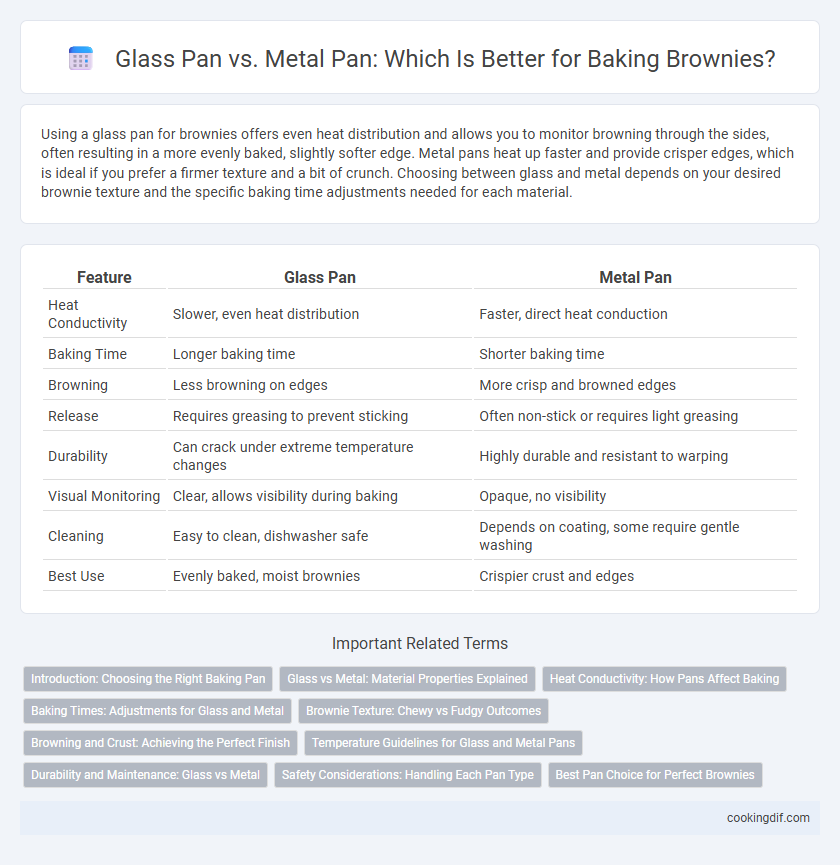Using a glass pan for brownies offers even heat distribution and allows you to monitor browning through the sides, often resulting in a more evenly baked, slightly softer edge. Metal pans heat up faster and provide crisper edges, which is ideal if you prefer a firmer texture and a bit of crunch. Choosing between glass and metal depends on your desired brownie texture and the specific baking time adjustments needed for each material.
Table of Comparison
| Feature | Glass Pan | Metal Pan |
|---|---|---|
| Heat Conductivity | Slower, even heat distribution | Faster, direct heat conduction |
| Baking Time | Longer baking time | Shorter baking time |
| Browning | Less browning on edges | More crisp and browned edges |
| Release | Requires greasing to prevent sticking | Often non-stick or requires light greasing |
| Durability | Can crack under extreme temperature changes | Highly durable and resistant to warping |
| Visual Monitoring | Clear, allows visibility during baking | Opaque, no visibility |
| Cleaning | Easy to clean, dishwasher safe | Depends on coating, some require gentle washing |
| Best Use | Evenly baked, moist brownies | Crispier crust and edges |
Introduction: Choosing the Right Baking Pan
Selecting the right baking pan significantly affects brownie texture and bake quality. Glass pans distribute heat evenly, creating a moist, tender brownie with slightly crispy edges, while metal pans offer faster heat conduction that results in a firmer crust and quicker bake time. Understanding these material differences helps bakers achieve the desired consistency and overall flavor in their brownies.
Glass vs Metal: Material Properties Explained
Glass pans offer even heat distribution and retain heat longer, resulting in more consistent baking and edges that brown gradually. Metal pans conduct heat faster and provide a crispier crust with sharper edges due to their superior thermal conductivity. Understanding these material properties helps bakers choose the ideal vessel to achieve desired brownie texture and baking precision.
Heat Conductivity: How Pans Affect Baking
Metal pans offer superior heat conductivity, ensuring even heat distribution that promotes consistent brownie baking and a crisper crust. Glass pans heat more slowly but retain heat longer, which can cause brownies to bake unevenly with edges cooking faster than the center. Choosing metal or glass pans significantly impacts the texture and baking time of brownies due to their distinct thermal properties.
Baking Times: Adjustments for Glass and Metal
Glass pans require longer baking times than metal pans because glass heats more evenly but retains heat, causing brownies to continue cooking after removal from the oven. Metal pans conduct heat faster, shortening baking times and promoting crispier edges, which means brownies can be tested for doneness earlier. Adjust baking times by reducing 5 to 10 minutes when using metal pans compared to glass to prevent overbaking and achieve the desired texture.
Brownie Texture: Chewy vs Fudgy Outcomes
Using a glass pan for baking brownies results in a slower, more even heat distribution, producing edges that are firmer and a chewy texture throughout. Metal pans conduct heat quickly, creating crispier crusts with moist, fudgy centers that intensify the classic brownie experience. Choosing between glass and metal pans directly influences the balance between chewy and fudgy brownie textures based on thermal conductivity and baking time variations.
Browning and Crust: Achieving the Perfect Finish
Glass pans distribute heat evenly, promoting consistent browning and a glossy crust on brownies, while metal pans conduct heat faster, resulting in sharper edges and a firmer crust. Metal pans often create a crispier exterior due to their higher heat retention, enhancing the contrast between the fudgy interior and crunchy outer layer. Choosing between glass and metal depends on desired texture, with glass favoring softer crusts and metal yielding a more pronounced finish.
Temperature Guidelines for Glass and Metal Pans
Glass pans typically require a temperature reduction of 25 degrees Fahrenheit compared to metal pans due to their heat retention properties, which can cause brownies to cook faster and potentially burn. Metal pans conduct heat more efficiently, allowing for more even baking at the recipe's recommended temperatures without adjustment. Understanding these temperature guidelines ensures optimal brownie texture and prevents overbaking or undercooking depending on the baking vessel used.
Durability and Maintenance: Glass vs Metal
Glass pans offer excellent durability due to their resistance to scratches and stains, maintaining clarity over time, though they are more prone to breaking if dropped. Metal pans, typically made from aluminum or stainless steel, provide superior durability against impacts and bending, but may require regular maintenance to prevent rust and maintain non-stick properties. Cleaning glass pans is generally easier as they don't retain odors or stains, whereas metal pans often need seasoning or special coatings to ensure longevity and easy release of baked brownies.
Safety Considerations: Handling Each Pan Type
Glass pans distribute heat evenly but retain heat longer, requiring oven mitts for extended cooling to prevent burns. Metal pans heat up quickly and cool faster, making them easier to handle shortly after baking but increasing the risk of hot spots and uneven cooking. Both pan types demand cautious handling to avoid thermal shock or burns during insertion and removal from the oven.
Best Pan Choice for Perfect Brownies
Glass pans distribute heat more evenly, preventing hot spots and ensuring brownies bake uniformly with a consistent texture. Metal pans, especially those made of aluminum, heat up quickly and provide a crisper edge, ideal for those who prefer a slightly crunchy brownie crust. Choosing between glass and metal depends on desired brownie texture: glass for soft, chewy centers and metal for firmer, crispier edges.
Glass Pan vs Metal Pan for baking vessel Infographic

 cookingdif.com
cookingdif.com